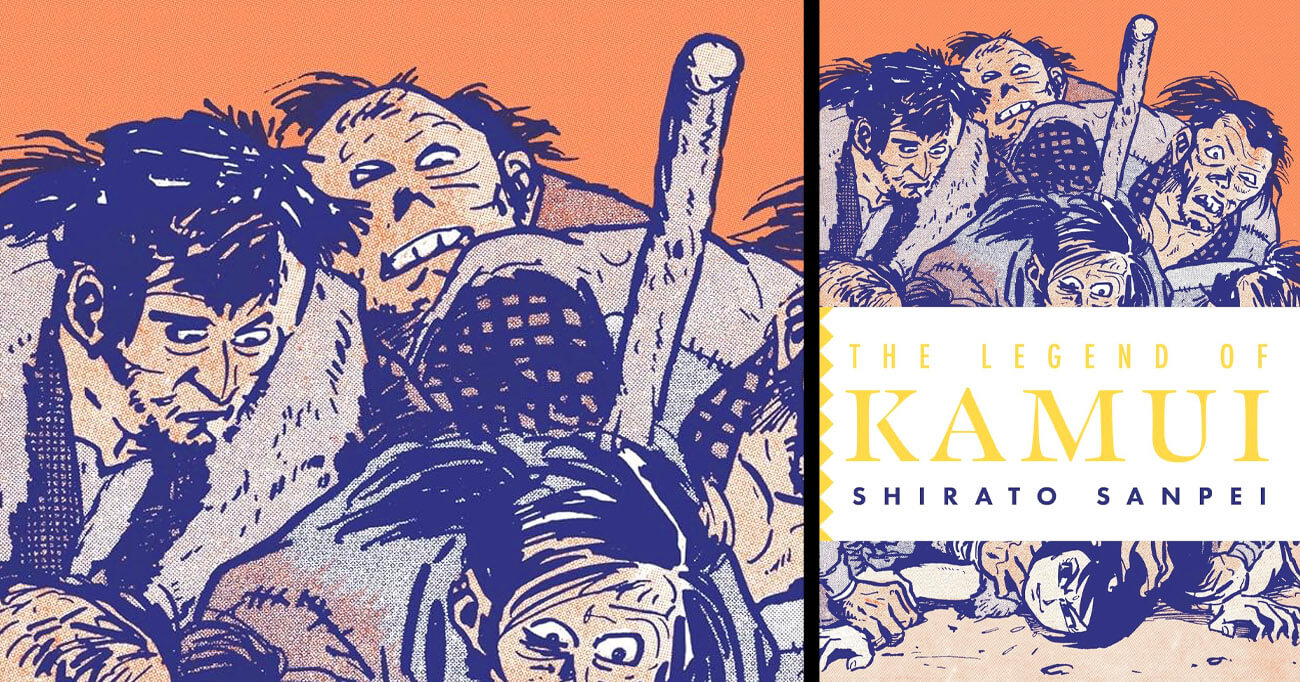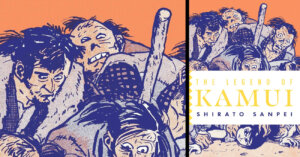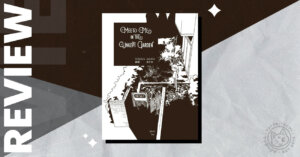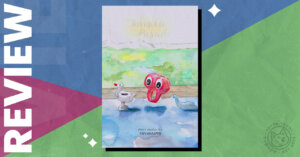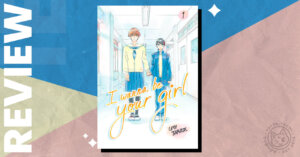Legend precedes Shirato Sanpei’s manga series The Legend of Kamui. This series that sold over ten million copies with its successor Kamui Gaiden, first ran in Garo from 1964 to 1971, then in Shonen Sunday and Big Comic between 1982 and 1987. It is a beloved, influential and unabashedly political series. College students revered Shirato’s comics as revolutionary praxis. Manga critics dissected Kamui for its themes and deeper meanings. Yet the original 1964 series has never been published in English until this year.
I didn’t know what to expect going into Legend of Kamui, except that it supposedly had ninja in it. Would it be much like Lone Wolf and Cub, Kazuo Koike and Goseki Kojima’s tale of a lone assassin and his child living on the road? Or perhaps something closer to the stylish violence of Hiroaki Samura’s Blade of the Immortal? The manga I have read, even the older titles, have laid certain expectations for what to expect: episodic plots built around memorable characters who overcome challenges through individual will.
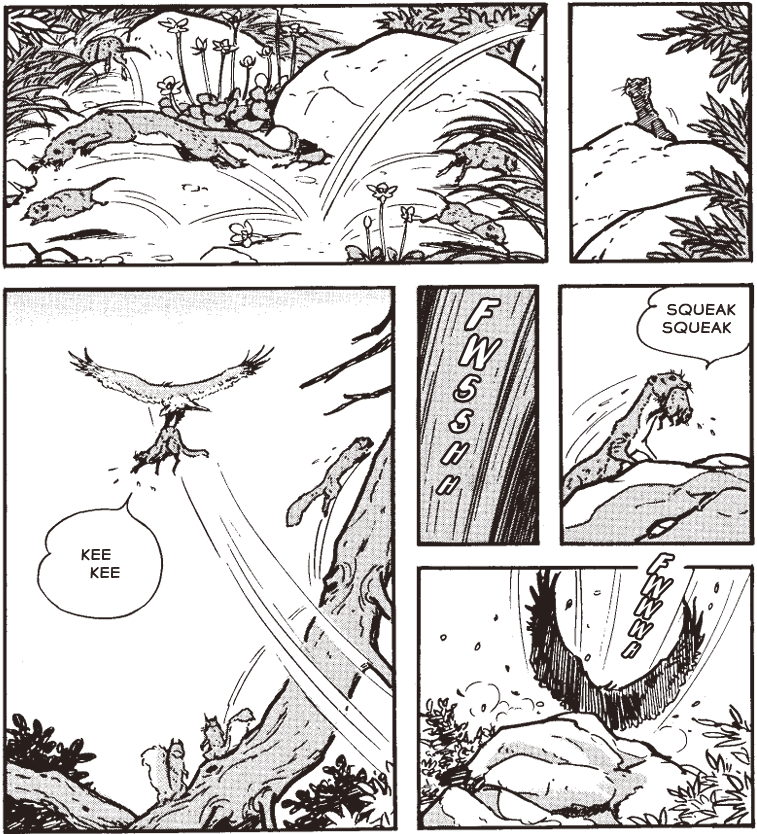
Dead dogs
Legend of Kamui’s opening pages flummoxed me. First we see nature, and the cycle of life: a rodent is gobbled up by a weasel, who is snatched by a hawk. Frantic birds drop seeds eaten by deer who run from a bear munching fish. When the bear rubs its back on a tree, shaken monkeys scare rabbits that are then killed by a wild-eyed man of the woods. “Kamui!” he says. Could this be him? But no: we jump to Hioki Castle as a ring of nobles on horses shoot dogs to death with arrows for fun. Nature is cruel; but humans may be crueler.
It is the 1640s and Japan toils under the feudal system. As samurai fight each other for influence, farmers and genin struggle to grow enough rice to meet absurd metrics. Beneath them, the outcast caste dispose of dead animals and are subject to daily abuse. Rebels are brutally tortured and killed. The upper classes encourage the lower classes to distrust each other. Life is cheap. Even an individualistic hero, blessed by talent and skill, might fail under such odds.
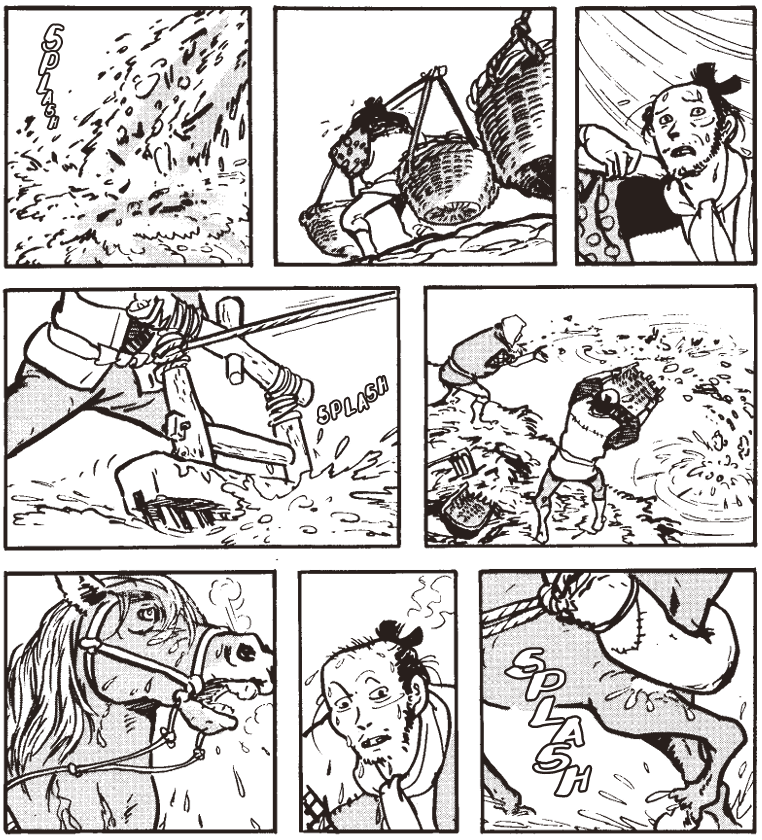
An intimidating read
At over six hundred pages, this volume is an intimidating read. Shirato repeatedly changes focus between farmers, outcasts, animals and feudal lords. Characters rise from the sea of narrative and submerge just as suddenly. Their lives knit together into a narrative of struggle. Yet Shirato demands that the reader track these connections across hundred-page long scene changes until they become relevant once again.
Eventually the key characters distinguish themselves. Shosuke, a kind young genin and the son of the runner Danzuri. Ryuinoshin, the son of samurai Kusaka Kanbei and a gifted swordsman. Omine, a female farmer who cannot love who she wants under the feudal system. Then there is Kamui, a young outcast who clearly sees society’s contradictions. Every day he fights to become strong and rise above a world that seeks to destroy him. Yet even Kamui can only go so far…
Floating above the characters and their struggles is the voice of the author himself, Shirato Shirato. He expounds on various concepts, like the irrigation of rice and the taxation of peasant communities, throughout the story in block paragraphs. While he presents himself as an authority within the text, though, he can’t help but question himself. A memorable early story follows a white wolf exiled by their gray peers and left to survive on their own. It is clearly a parallel to Kamui himself. Yet Shirato moans at the end of this storyline that “It seems I have gone on for too long about the lives of wolves.” The natural world, he says, cannot parallel the workings of history.
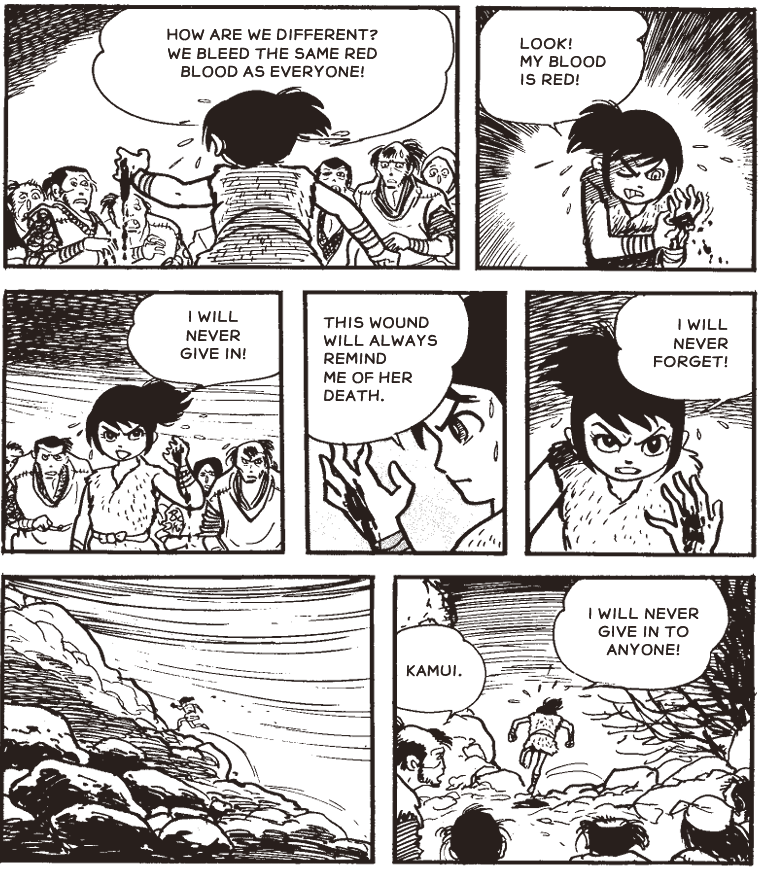
If you’re fed up, do something
Shirato’s politics are visible for all to see on the page. In one scene, young Kamui speaks like a union organizer: “the more you tremble the more they’ll exploit you! If you’re fed up, do something!” In another, Ryuinoshin discusses the history of swordsmanship with the scholar Ishuin. Ryuinoshin hopes to devote his life to the blade. But Ishuin insists that “bushido” has only ever been a means for the rich to maintain power at the expense of the poor. “Training in swordsmanship,” he says, “no matter how you put it, essentially enables a person to kill as many people as possible.”
The Legend of Kamui sympathizes first with outcasts like Kamui, then with genin like Shosuke. The samurai are portrayed more often than not as leering officials who take what they want and leave their supposed inferiors to fight to death over the scraps. Yet the samurai, Shirato insists, are not the true enemy. It is the feudal system itself that constrains possibility and ensures never ending suffering. The samurai are just as vulnerable to this lack of imagination.
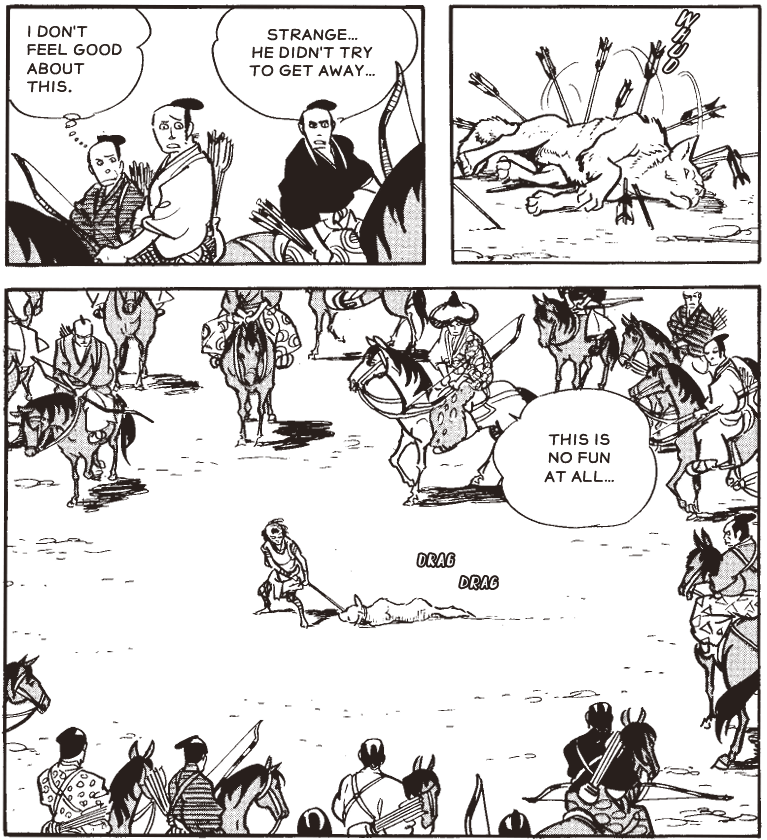
Eventually, they would disappear
Shirato also demonstrates how people of lower social classes are encouraged to hurt each other. One of the first characters we meet is Shunsuke’s father Danzuri. He’s the fastest runner in his village and a pillar among genin. Yet the other farmers condescend to him because he is a member of the genin class. Later in the narrative, Danzuri serves dog food to members of the outcast class. How could he treat the outcasts that way, his son Shosuke laments, when he has been mistreated in turn by his own superiors? Even a “good man” like Danzuri though cannot imagine an alternative to the feudal system. He beats his son, insists that he is correct and then runs away.
The Legend of Kamui takes place in a world without hope. “The characters in our story,” Shirato writes, “struggled to survive within the system to which they were born. And eventually, they would disappear.” In this first volume, nobody lives long enough to see a world free of the contradictions that have determined the path of their lives. Neither will their children. Yet they all fight anyway–Kamui, Shunsuke, Omine, even Ryuinoshin–in the hopes that they might one day achieve their dreams.
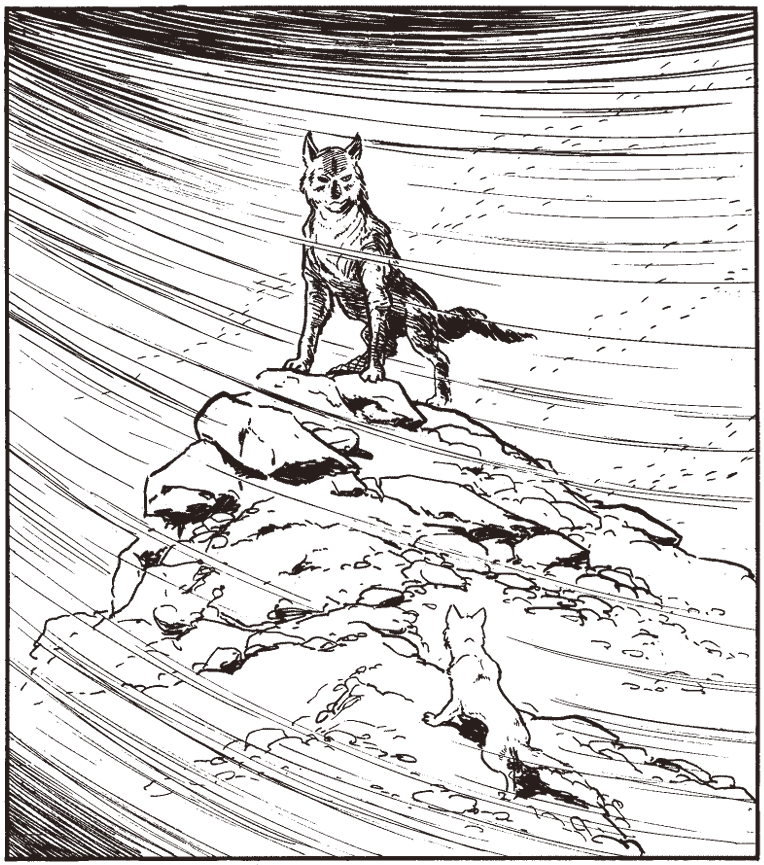
The world from every angle
Modern manga follows strong individual characters. They pursue their needs across a world built to facilitate their desires, and either achieve them or don’t. That narrative has been repackaged across genres, markets and audiences. Nearly every manga series published in English follows this paradigm because it sells.
The Legend of Kamui, though, was drawn before that paradigm fully took shape. As it is set during a time when the individual could not overcome history it lacks a main character. Therefore Shirato depicts a group struggle across social classes for self-determination. The point is not to empathize with any one character but to see the world from every angle: nature, violence, love, ritual, death. Only then can its many contradictions be understood. The reader may then apply that lens to our own contradictory world.
This series is unmistakably a product of its time and the worldview of its creator. Yet that is a blessing rather than a curse. Even the best of today’s comics are shaped by market realities. Shirato on the other hand was handed a platform from which to draw stories without compromise. The results can be depressing, exhausting, confusing–but also holistic in a way that I find beautiful.
The Verdict:
The first volume of The Legend of Kamui demands a close reading, but will reward your efforts. Nothing you have read will prepare you for this book.
You can purchase The Legend of Kamui via Bookshop, Barnes and Noble and Amazon.
If you liked The Legend of Kamui, you might like…
- Lone Wolf and Cub
- Phoenix: Karma
- Onward Towards Our Noble Deaths
Credits:
Story and Art: Shirato Sanpei
Translation: Richard Rubinger and Noriko Rubinger
Additional Translation: Alexa Frank
Lettering: Michael DeForge
Published by: Drawn & Quarterly
A special thank you to Drawn & Quarterly for allowing us the opportunity to review this title. Receiving a review copy has in no way altered the opinions expressed in this article.
The Good
- Singular work of comics genius previously unavailable in English
- Excellent illustrations of nature, animals, violence
- Will teach you everything you ever wanted to know about rice irrigation and taxation
The Bad
- 600 pages of dense, unhappy reading
- Dozens of characters can be tough to tell apart
- Didactic to a fault

Featured Sponsor - JAST
The sweetest romance and the darkest corruption, the biggest titles and the indie darlings; for visual novels and eroge, there's nowhere better.
Big thank you to our supporters
From their continous support, we are able to pay our team for their time and hard work on the site.
We have a Thank-You page dedicated to those who help us continue the work that we’ve been doing.
See our thank you page